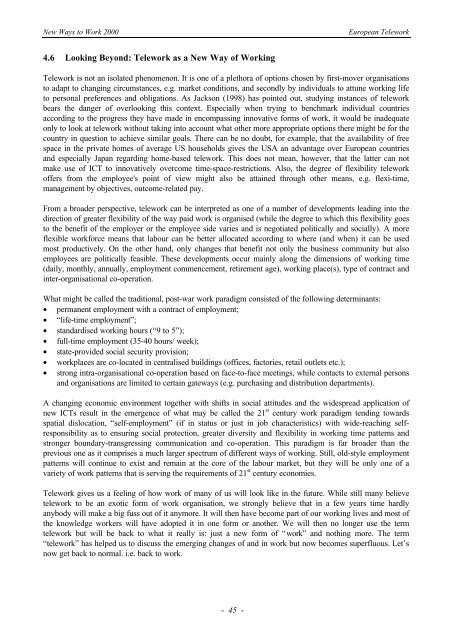eWORK 2000 - European Telework Week
eWORK 2000 - European Telework Week
eWORK 2000 - European Telework Week
- No tags were found...
Create successful ePaper yourself
Turn your PDF publications into a flip-book with our unique Google optimized e-Paper software.
New Ways to Work <strong>2000</strong><strong>European</strong> <strong>Telework</strong>4.6 Looking Beyond: <strong>Telework</strong> as a New Way of Working<strong>Telework</strong> is not an isolated phenomenon. It is one of a plethora of options chosen by first-mover organisationsto adapt to changing circumstances, e.g. market conditions, and secondly by individuals to attune working lifeto personal preferences and obligations. As Jackson (1998) has pointed out, studying instances of teleworkbears the danger of overlooking this context. Especially when trying to benchmark individual countriesaccording to the progress they have made in encompassing innovative forms of work, it would be inadequateonly to look at telework without taking into account what other more appropriate options there might be for thecountry in question to achieve similar goals. There can be no doubt, for example, that the availability of freespace in the private homes of average US households gives the USA an advantage over <strong>European</strong> countriesand especially Japan regarding home-based telework. This does not mean, however, that the latter can notmake use of ICT to innovatively overcome time-space-restrictions. Also, the degree of flexibility teleworkoffers from the employee's point of view might also be attained through other means, e.g. flexi-time,management by objectives, outcome-related pay.From a broader perspective, telework can be interpreted as one of a number of developments leading into thedirection of greater flexibility of the way paid work is organised (while the degree to which this flexibility goesto the benefit of the employer or the employee side varies and is negotiated politically and socially). A moreflexible workforce means that labour can be better allocated according to where (and when) it can be usedmost productively. On the other hand, only changes that benefit not only the business community but alsoemployees are politically feasible. These developments occur mainly along the dimensions of working time(daily, monthly, annually, employment commencement, retirement age), working place(s), type of contract andinter-organisational co-operation.What might be called the traditional, post-war work paradigm consisted of the following determinants:• permanent employment with a contract of employment;• “life-time employment”;• standardised working hours (“9 to 5”);• full-time employment (35-40 hours/ week);• state-provided social security provision;• workplaces are co-located in centralised buildings (offices, factories, retail outlets etc.);• strong intra-organisational co-operation based on face-to-face meetings, while contacts to external personsand organisations are limited to certain gateways (e.g. purchasing and distribution departments).A changing economic environment together with shifts in social attitudes and the widespread application ofnew ICTs result in the emergence of what may be called the 21 st century work paradigm tending towardsspatial dislocation, “self-employment” (if in status or just in job characteristics) with wide-reaching selfresponsibilityas to ensuring social protection, greater diversity and flexibility in working time patterns andstronger boundary-transgressing communication and co-operation. This paradigm is far broader than theprevious one as it comprises a much larger spectrum of different ways of working. Still, old-style employmentpatterns will continue to exist and remain at the core of the labour market, but they will be only one of avariety of work patterns that is serving the requirements of 21 st century economies.<strong>Telework</strong> gives us a feeling of how work of many of us will look like in the future. While still many believetelework to be an exotic form of work organisation, we strongly believe that in a few years time hardlyanybody will make a big fuss out of it anymore. It will then have become part of our working lives and most ofthe knowledge workers will have adopted it in one form or another. We will then no longer use the termtelework but will be back to what it really is: just a new form of “work” and nothing more. The term“telework” has helped us to discuss the emerging changes of and in work but now becomes superfluous. Let’snow get back to normal. i.e. back to work.- 45 -








